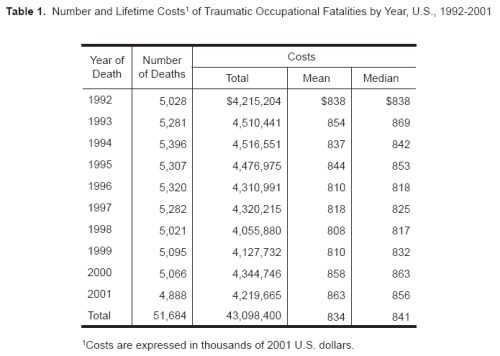The Hidden Cost of Workplace Fatalities: 43 Billion Dollars
 While even the non-fatal injury can cost a company ten’s of thousands of dollars (as noted in OHShub.com’s post: The Hidden Cost of Unsafe Behavior: Running the Numbers, even more unbelievable is the cost of a fatality. NIOSH has produced a document entitled, The Cost of Fatal Injuries to Civilian Workers in the United States, detailing a decade of research (1992 – 2001) into the economic aspect of a workplace fatality.
While even the non-fatal injury can cost a company ten’s of thousands of dollars (as noted in OHShub.com’s post: The Hidden Cost of Unsafe Behavior: Running the Numbers, even more unbelievable is the cost of a fatality. NIOSH has produced a document entitled, The Cost of Fatal Injuries to Civilian Workers in the United States, detailing a decade of research (1992 – 2001) into the economic aspect of a workplace fatality.
The method used to calculate the economic burden was the cost-of-illness method: which sums indirect and direct costs. The cost-of-illness method was used to calculate the mean, median, and total societal costs for the fatalities reported in National Traumatic Occupational Fatalities surveillance system (NTOF).
Indirect costs are calculated for each incident by accounting for the probability of survival, median annual earnings at the time of death, home production costs, earnings growth rate adjustments, and real discount rate. These costs are then added to the direct cost of medical expenses to arrive at the societal cost of fatal injury. The addition of home production costs to this model represents an advancement in methodology over models which simply account for loss of income from wages and presents a point of departure from previous studies. Limitations of this study are varied and include lack of inclusion of some costs of insurance compensation, lack of comprehensiveness of data drawn from death certificates and pay equity.
After the calculations are preformed, over $43 billion dollars (in 2001 dollars) is the cumulative cost for occupational fatalities in the US.
Some of the major findings included:


